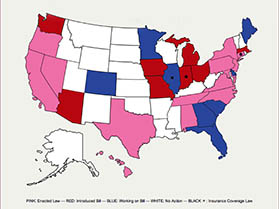Cronkite News has moved to a new home at cronkitenews.azpbs.org. Use this site to search archives from 2011 to May 2015. You can search the new site for current stories.
Lawmaker: Make doctors disclose ‘dense’ breast tissue and implications
PHOENIX – Paty De La Rosa-Acosta had just finished swimming on a sunny day in July 2012 when she noticed that her right breast seemed “perkier” than the other.
Each of her regular mammograms had come back normal over the years, but she would find out that her right breast had a tumor – 9 centimeters when confirmed – that was difficult to detect because she has dense breast tissue.
“When I was diagnosed, I thought I was doing everything. I was practicing prevention, I was doing my mammograms and I was doing my checkups,” she said. “I was doing my part to know that I was healthy. I felt cheated.”
De La Rosa-Acosta was at the State Capitol on Jan. 29 to support legislation that would require primary care physicians to inform patients if their breasts are considered dense, making them more likely to develop breast cancer and making tumors more difficult to detect through mammograms.
Sen. Nancy Barto, R-Phoenix, author of SB 1225, said patients should have full disclosure about their health when deciding what types of tests to run.
“I think it’s a very important piece of legislation in order to make sure that patients have all the information they need in order to make a decision about their health, in regards to breast cancer,” she said.
The bill received a unanimous endorsement from the Senate Health and Human Services Committee, which Barto chairs.
A patient’s breast tissue is assessed on a scale ranging from almost entirely fatty to extremely dense. Tissue density is already marked on mammogram results; however, primary care physicians aren’t legally obligated to inform their patients about it.
Dr. Nicole Saphier, a Scottsdale-based radiologist, said dense breast tissue makes it difficult for radiologists to see cancerous cells because those show up as the same color as dense, fibrous tissue: white, whereas fatty tissue appears as black. About half of women have dense or extremely dense breast tissue, which puts them at higher risk of developing cancer.
Saphier said the case of De La Rosa-Acosta, who wasn’t her patient, illustrates the problem. By the time her tumor was discovered, it was quite large and required a double mastectomy, six months of chemotherapy and radiation to treat.
“It was still not seen in the mammography,” Saphier said. “That’s how scary that is because her breasts were so dense.”
Dr. Belinda Barclay-White, a radiologist at Arizona Breastnet specializing in breast imaging, said that doctors and radiologists miss one cancer in every 300 women with dense breasts.
Her office explains to every patient about breast density, as well as the pitfalls of mammography for women with dense breasts. She said it’s important to make sure her patients understand their health, and the tests used to assess it.
“As a woman, I would want to know the pros and cons of a mammogram,” she said.
Fourteen states require physicians to disclose a patient’s breast density. That list includes Connecticut, where Dr. Nancy Cappello said she pressed for the change after being diagnosed with advanced breast cancer.
“I tried to get information about the dense tissue, and no one bothered to tell me,” she said in a telephone interview. “I knew that there were other women just like me that were having cancers missed. And what happens when it’s missed year after year, you have advanced cancer.”
Cappello also founded Are You Dense? an educational nonprofit aimed at informing women about breast density and how it affects the likelihood of breast cancer. A sister organization, “Are You Dense? Advocacy,” lobbies at statehouses and in Congress.
The Arizona Hospital and Healthcare Association registered as neutral on Barto’s bill. A representative didn’t return a telephone message seeking comment.
De La Rosa-Acosta’s cancer is in remission, although she says her doctor tells she has a 53 percent chance of it returning because of the size of her tumor. Now she said she’s dedicated to making sure other women are aware of their breast density and its implications.
“They didn’t tell me that dense tissue really means we can’t see anything,” she said. “The picture looks normal, but we can’t get a true picture. That’s what I should of been told.”







